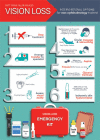Consensus Opinion for The Management of Soft Tissue Filler Induced Vision Loss
- PMID: 35096260
- PMCID: PMC8794490
Consensus Opinion for The Management of Soft Tissue Filler Induced Vision Loss
Abstract
There are multiple treatment strategies proposed for the management of vision loss related to the injection of soft tissue fillers. Currently, there is no internationally accepted consensus on the immediate management of soft tissue filler induced vision loss (STFIVL). A recent systematic review of the literature concluded that there is not enough evidence to support retrobulbar hyaluronidase, and alternative treatments require exploration. The available literature demonstrates the inconsistent and unproven success of retrobulbar and peribulbar hyaluronidase in reversal of soft filler induced vision loss. Various therapeutics have been used to aid the reversal of vision loss but with mixed outcomes. The current evidence base does not support the use of retrobulbar and peribulbar hyaluronidase. The use of retrobulbar hyaluronidase for reversing soft tissue filler induced vision loss is controversial. Its efficacy remains unproven and there is mixed evidence within the literature. The current evidence suggests that there may be an increased risk of introducing severe adverse events associated with retrobulbar hyaluronidase and may even exacerbate the problem for those clinicians who are not ophthalmology trained. Therefore, we recommend two alternative treatment pathways for ophthalmology and non-ophthalmology trained practitioners. The suggested goal of this publication is to understand the pathophysiology of STFIVL, recognize signs and symptoms, and to propose algorithms to manage vision loss for both non-ophthalmology and ophthalmology trained clinicians. Clinicians must act swiftly and arrange immediate transfer to an emergency department or ophthalmology specialist setting to give the patient the best chance of vision restoration. The focus of any intervention for non-ophthalmology trained clinicians should be based around the immediate use of non-invasive techniques.
Keywords: Vision loss; blindness; central retinal artery; complications; filler; hyaluronic acid; hyaluronidase; ophthalmic artery; ophthalmology; risk, algorithm; soft tissue.
Copyright © 2021. Matrix Medical Communications. All rights reserved.
Conflict of interest statement
DISCLOSURES: The authors report no conflicts of interest relevant to the content of this article.
Figures
Similar articles
-
Examining the Role of Retrobulbar Hyaluronidase in Reversing Filler-Induced Blindness: A Systematic Review.Ophthalmic Plast Reconstr Surg. 2020 May/Jun;36(3):231-238. doi: 10.1097/IOP.0000000000001568. Ophthalmic Plast Reconstr Surg. 2020. PMID: 31880685
-
Efficacy of Retrobulbar Hyaluronidase Injection for Vision Loss Resulting from Hyaluronic Acid Filler Embolization.Aesthet Surg J. 2017 Dec 13;38(1):12-22. doi: 10.1093/asj/sjw216. Aesthet Surg J. 2017. PMID: 28333176
-
Effectiveness of Retrobulbar Hyaluronidase Injection in an Iatrogenic Blindness Rabbit Model Using Hyaluronic Acid Filler Injection.Plast Reconstr Surg. 2019 Jul;144(1):137-143. doi: 10.1097/PRS.0000000000005716. Plast Reconstr Surg. 2019. PMID: 31246817
-
Reversal of Post-filler Vision Loss and Skin Ischaemia with High-Dose Pulsed Hyaluronidase Injections.Aesthetic Plast Surg. 2019 Oct;43(5):1337-1344. doi: 10.1007/s00266-019-01421-6. Epub 2019 Jun 24. Aesthetic Plast Surg. 2019. PMID: 31236610
-
Update in Soft-Tissue Filler-Associated Blindness.Dermatol Surg. 2020 May;46(5):671-677. doi: 10.1097/DSS.0000000000002108. Dermatol Surg. 2020. PMID: 31490297 Review.
Cited by
-
Ophthalmological Complications of Aesthetic Medicine Procedures: A Narrative Review.J Clin Med. 2025 Jul 31;14(15):5399. doi: 10.3390/jcm14155399. J Clin Med. 2025. PMID: 40807018 Free PMC article. Review.
-
Best Practices for the Use of High-Frequency Ultrasound to Guide Aesthetic Filler Injections-Part 1: Upper Third of the Face.Diagnostics (Basel). 2024 Aug 8;14(16):1718. doi: 10.3390/diagnostics14161718. Diagnostics (Basel). 2024. PMID: 39202206 Free PMC article.
-
Retinal artery occlusion after facial filler injection in a patient with patent foramen ovale: a case report and literature review.J Int Med Res. 2023 Sep;51(9):3000605231194514. doi: 10.1177/03000605231194514. J Int Med Res. 2023. PMID: 37728598 Free PMC article. Review.
-
Bridging a Century-Old Problem: The Pathophysiology and Molecular Mechanisms of HA Filler-Induced Vascular Occlusion (FIVO)-Implications for Therapeutic Interventions.Molecules. 2022 Aug 24;27(17):5398. doi: 10.3390/molecules27175398. Molecules. 2022. PMID: 36080164 Free PMC article. Review.
-
Essential Pharmaceutical Drugs in the Filler Emergency Kit.Aesthetic Plast Surg. 2025 Jul;49(14):4043-4056. doi: 10.1007/s00266-025-04808-w. Epub 2025 Mar 31. Aesthetic Plast Surg. 2025. PMID: 40164895 Review.
References
-
- Beleznay K, Carruthers JDA, Humphrey S et al. Update on avoiding and treating blindness from fillers: a recent review of the world literature. Aesthet Surg J. 2019;39:662–674. - PubMed
-
- Jones DH, Fitzgerald R, Cox SE et al. Preventing and Treating Adverse Events of Injectable Fillers: Evidence-Based Recommendations From the American Society for Dermatologic Surgery Multidisciplinary Task Force. Dermatol Surg. 2021;47(2):214–226. - PubMed
-
- Cho KH, Dalla Pozza E, Toth G et al. Pathophysiology Study of Filler-Induced Blindness. Aesthet Surg J. 2019;39(1):96–106. - PubMed
-
- Khan TT, Colon-Acevedo B, Mettu P et al. An Anatomical Analysis of the Supratrochlear Artery: Considerations in Facial Filler Injections and Preventing Vision Loss. Aesthet Surg J. 2017;37(2):203–208. - PubMed
Publication types
LinkOut - more resources
Full Text Sources





